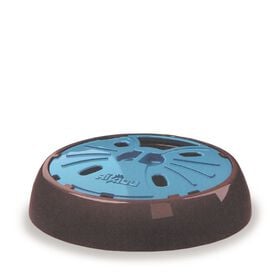Teething is a natural developmental phase for puppies, much like for human babies. During this stage, your puppy may experience discomfort, which can be distressing for you and your furry little friend. However, with the right approach and preparation, you can help ease your puppy's discomfort and navigate this stage with minimal damage.

Why does your puppy need to chew?
Chewing is a necessary part of your puppy's development. Between the ages of 5 and 20 weeks, your puppy learns:
- To communicate their needs (hunger, fatigue, need to relieve themselves, etc.)
- How to self-regulate and calm down when experiencing strong emotions (excitement, fear, or frustration).
- To recognize textures, shapes, and sensations (chewing also serves as a way for them to explore their surroundings).
Signs your puppy is teething
Signs of teething may vary from puppy to puppy, but here are some commonly observed indicators:
- Increased chewing: your puppy might seek to chew more frequently, often on hard objects or furniture.
- Excessive drooling: saliva production may increase while teething.
- Irritability and restlessness: your puppy might seem more irritable or restless than usual due to discomfort.
- Loss of appetite: some puppies may temporarily lose their appetite during teething.
- Swollen or red gums: examining the gums may reveal inflammation or redness, indicating teething is underway.
Keep a close eye on these signs to help your puppy through this stage more comfortably.
Also read: Tips for introducing your puppy to their forever home

How to help your puppy
Helping your puppy through this phase requires patience and the right approach. Here are some ways to make it easier:
Addressing your puppy's chewing needs
- Ensure your puppy has ample opportunities to chew by offering meals and treats in a dispenser toy or providing chew sticks.
- Since puppies get tired quickly, opt to increase the frequency of chewing activities rather than their length. For instance, fill your puppy's dispenser toy 3-4 times a day.
- Establish a routine that suits both you and your puppy. Offering chewing activities too sporadically or at inappropriate times won't be beneficial. Aim for predictability and choose moments when your puppy seems most in need of chewing.
Your puppy learns through play
- When choosing toys for your dog, select soft toys that won't harm their growing teeth.
- Keep play sessions brief, around 8 to 12 minutes, to avoid overstimulation and grumpiness. It's better to play more often but for shorter durations and adjust to their energy level.
- Start and end playtime with your puppy calmly to help them regulate their excitement level.
- Use "take" and "give" commands to teach your puppy the difference and make your interactions pleasurable.
The best chew toys for puppies
Think safety and fun when choosing the perfect toy for your teething puppy! Here are some options to consider:
- Fabric chew toys: fabric toys, like braided ropes, are ideal for your puppy to chew on safely.
- Freezable toys: toys specially designed to be frozen can provide additional relief by numbing your puppy's gums.
- Interactive toys: these entertaining toys can keep your puppy busy while helping them focus on something other than their gums.
- Soft rubber bones: they're specially designed for puppies, avoiding any risk of dental injury.
With these toys within reach, your puppy can chew on something other than your favourite pair of shoes!

How to prevent puppy chewing?
It's impossible to entirely prevent puppies from chewing because it's a natural part of their development. However, there are ways to manage it. Here are three essential tips:
- Avoid physical or verbal corrections: they only exacerbate chewing and your puppy's frustration or hinder learning. For example, yelling "no," pinching your puppy's lips, shutting their jaws, etc.
- Avoid giving your puppy toys or chewing bones that are too hard: it can lead to gum inflammation, making the situation worse. To select appropriate items, ensure the toys are elastic and malleable and can be squeezed with your hand. You should also be able to bend or even break in half chew bones.
- Consult a specialist: consider seeking guidance from a professional dog trainer or behaviour specialist. With their expertise, you can learn to recognize when your pup needs to chew and how to redirect their nibbling behaviour.
Also read: Puppy potty training 101: a step-by-step guide
Responding to puppy chewing
Responding appropriately when your puppy chews something they're not supposed to is essential. Here are some tips to ensure that your puppy learns from your interventions:
- Use appropriate "punishment": sometimes, the best way to discourage your puppy from chewing is to withdraw from the interaction. It sends a clear message to your puppy that their behaviour is unacceptable.
- Signal the intensity of the chewing: if your puppy bites your skin or clothes, make a slight, high-pitched sound to indicate it's too much. If your puppy backs off, give them a toy to redirect their attention. If they continue to chew on inappropriate items, you can try to divert their attention again or withdraw to another room for a few seconds before repeating the process.
These interventions aim to train your puppy to reduce their chewing habit until it completely stops. Supervising young children when they need to intervene with the puppy is advisable.
Tips to protect your belongings
If you have a teething puppy at home, you know how challenging it can be to protect your furniture and other valuable items. However, you can take some simple steps to safeguard your home. Here are some tips:
- Keep valuable objects out of reach: store valuable items in a secure location out of your puppy's reach to prevent it from being tempted to chew on them.
- Use safety barriers: limit access to areas where your puppy could cause damage. You can use baby gates or other safety barriers to keep your puppy in a designated area.
- Provide acceptable alternatives: to distract your puppy from forbidden objects, offer a variety of chew toys and dental treats. It will help satisfy their teething needs and keep them from chewing on your belongings.
- Monitor and intervene: keep an eye on your puppy and gently intervene if they target something they shouldn't. You can redirect their attention to an acceptable chew toy.
These simple steps can protect your home while helping your puppy navigate this growth stage.
During this time, it's essential to be patient with your puppy and give them plenty of love and attention. Remember that this phase will pass once your puppy's teeth have come in.











